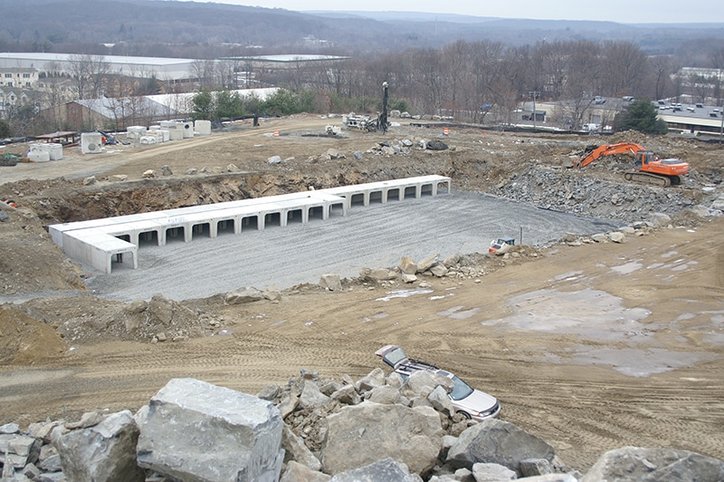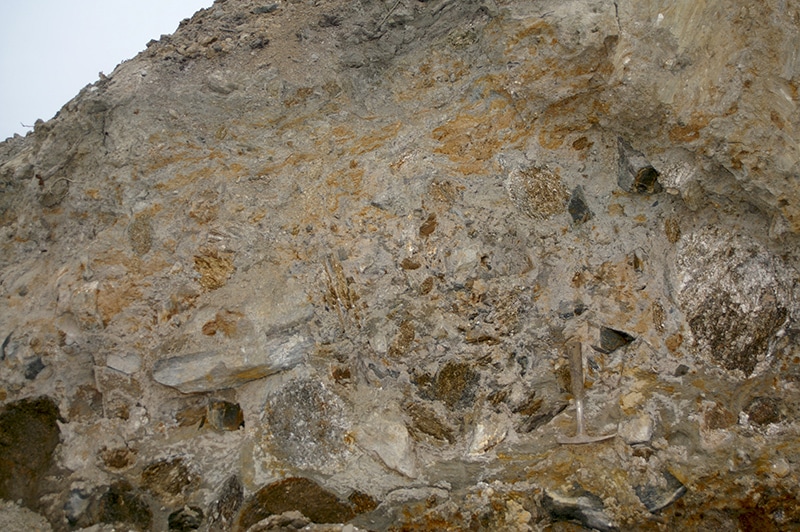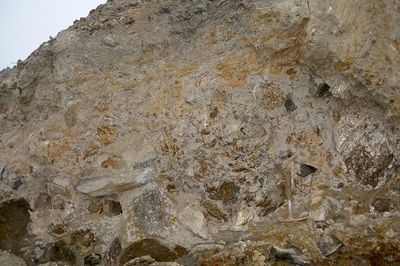With its proximity to Old Mine Park, a place famous for its topaz and fluorite-rich hydrothermal veins and amphibolite-hosted scheelite and ferberite pseudomorphs thereof, the defunct plaza and the new Home Depot construction were a magnet for mineral collecting. The bedrock is mostly amphibolite, with some marble, mapped as the Silurian basal member of the Silurian-Devonian The Straits Schist, which are locally very well exposed. There was generally little overburden of Pleistocene age on the site.
However, during the Home Depot construction a large, underground storm water storage gallery was constructed by blasting a chamber into the bedrock. This was presumably done because of the limited land available for a surface retention basin, so it was placed under the parking lot by filling the space with nested, hollow concrete structures that could support the overlying parking (see Figure 1). The walls of the gallery exposed mostly amphibolite bedrock, but the southeast corner revealed a layer of overlying glacial till.

Fig 1. Underground storm water retention basin under construction in January 2010. The walls exposed mostly amphibolite bedrock, but glacial till was exposed in the corner at far left (Harold Moritz photo).

Lower till lies directly on bedrock and given its compact nature was almost certainly formed under continental scale ice sheets and may have been overridden by multiple ice advances. Thus it could date back to the beginning of the Pleistocene 2.59 Ma and display evidence of deformation in the finer-grained matrix and decomposition of larger clasts. Such is the case at the Trumbull exposure.
The matrix at Trumbull is pale gray, very compact, unconsolidated silt and clay. But boulders and cobbles make up around half of the exposure. They are very tightly packed into the matrix and may be framework supported as they are almost touching in many areas and nearly fit together like a mortared stone wall. The matrix shows evidence of deformation from compaction, but also shows orange-rusty staining along fractures closer to the surface. The cobbles and boulders consist mostly of light colored to rusty schistose rocks, with only a few white marble and dark amphibolite rocks present despite their proximity. Interestingly, many of the schistose boulders were nearly completely decomposed, their feldspars altered to clays, and could be crumbled by simply scraping them with the small rock hammer shown. They were obviously very competent when emplaced but enough time has passed to allow in-situ weathering similar to the formation of saprolitic soil from bedrock, but in this case only within specific clasts. I’ve encountered similarly decomposed boulders in drill samples from lower till in Bantam, but never in upper till. Could this process have happened during only the latest glaciation of the past 100,000 years, or is it evidence that this till is from a much older Pleistocene glaciation?
Melvin, R. L.; Stone, B. D.; Stone, J. R.; & Trask, N. J. (1992), Hydrogeology of thick till deposits in Connecticut. U. S. Geological Survey open-File Report 92-43.
Stone, J. R.; Schafer, J.; London, E. H.; DiGiacomo-Cohen, M. L.; Lewis, R. S.; & Thompson, W. (2005), Quaternary Geologic Map of Connecticut and Long Island Sound Basin. USGS Scientific Investigations Map 2784.


